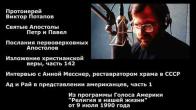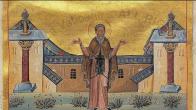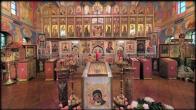You are here
April
- March 24/April 6 -- "Bountiful"
- March 25/April 7 -- "Annunciation" in Kiev
- April 3/16 -- "The Unfading Flower"
- April 4/17 -- "Gerondissa"
- April 7/20 -- Byzantine
- April 8/21 -- Shuiskaya
- April 12/25 -- "Muromskaya" , Belynich
- April 14/27 -- "Vilenskaya"
- April 16/29 -- "Ilyin Chernigov"
- Bright Tuesday -- Iveron Icon
- Bright Friday -- "The Life-giving Spring"
The Bountiful Icon
24 March/6 April
About 200 to 300 years ago, this icon could be found in one of the men’s monasteries of Tver. The rector gave the icon to Cosmas Volchaninov in thanks for his excellent work in the monastery church. The icon was passed on from generation to generation as a holy object. However, a certain impious grandchild of Cosmas put the inherited icon into his attic. His bride bore many insults from her husband and his relatives. In despair, the woman decided to commit suicide in a deserted bathhouse. Along the way, a monk appeared to her and said “Where are you going, unfortunate one? Turn back. Go, pray before the Mother of God of the Bountiful Hill, and you will live well and in peace.” Returning home, the distraught woman related everything that had happened, and even revealed her criminal intention to commit suicide. People looked for the monk, but he was nowhere to be found. No one other than she had seen him. This took place on the eve of the Feast of the Annunciation of the Most-holy Theotokos. The icon was immediately found in the attic, was cleaned, and was installed in a place of honor in their home. The parish priest, invited to visit that evening, came and served an All-night Vigil before the icon, and thereafter a Vigil was served before it yearly on that date. For more than 150 years, the icon remained in the Volchaninov family. When Ekaterina, daughter of Vasily, last of the Volchaninovs, married Georgi Ivanovitch Konyaev, she took the icon of the Mother of God with her as her most precious inheritance. In the Konyaev home, All-night Vigils continued to be served before the icon each March 24th and November 7th. Apparently, the latter was the day of the icon’s translation from the monastery to the home of Cosmas Volchaninof.
In 1863, it was decided to add a chapel, dedicated to Holy Hierarch Tikhon and Venerable St. Makary Kalyazinsky, to the Church of the Smolensk Icon of the Mother of God. Georgi Konyaev (+1868, at age 97), who was then curator of the icon, expressed the desire to donate the healing image of the Theotokos to the church. He approached the clergy with a request that yet another chapel be built, and dedicated to the Miraculous Icon of the “Bountiful Hill” Mother of God. He added, “I consider the Church of the Smolensk Icon of the Mother of God to be the best place for it, because the site upon which the church was erected was known in olden times as the hill, as it was the highest point in the town. During times of flood, the residents would take their possessions up that hill, and there would save themselves from ruin. “Let the Queen of Heaven, the Bountiful Hill, rest through her grace upon this hill and with her mercy cover all those buried here.” On July 15, 1866, the icon was transferred to the newly erected chapel, which on the following day was consecrated by Bishop Anthony of Staritsa.
In the icon, the Most-holy Theotokos is depicted standing on a semi-circular hill. In her left arm, she holds the Divine Infant, Whose right hand is raised in blessing. The Mother of God wears a crown, and in her hand holds a small hill, on top of which is visible a church with cupolas and crosses.
"Annunciation" - in Kiev: the Spinner Icon
25 March/7 April
On two columns supporting the arch over the altar in the St. Sophia Cathedral, are wonderfully preserved representations of the Annunciation. These Icons are above the level of the iconostasis. On the Northern Column the Archangel Gabriel is depicted, his face turned toward the Theotokos, announcing the news to the Most-holy Virgin. He wears a white khiton bearing three red stripes, or "springs." The stripes fall across his shoulders and on either side, [and he is wearing] gold cuffs. In his left hand is a red lily, while the right is raised, as if in blessing. Around his head a wreath is delineated in red. He wears sandals on his feet. To the left, at head level, there is the Greek inscription: "Archangel Gabriel," and then, going from right to left, the words of the Annunciation, "Rejoice, O thou who art full of Grace, the Lord is with thee."
The Most-holy virgin is depicted on the Southern column. Her clothing includes a long dark purple khiton, a similar head covering, edged with a gold fringe, which is visible at the bottom, falling to her left knee. The khiton is tied with a narrow red cincture. There are gold crosses on her head and on her shoulders. On her wrists are gold cuffs. In her left hand, which is upraised, she holds a scroll of red yarn, from which threads extend to the spindle in her right hand. She is shod in red footwear with gold stripes. The Most-holy Virgin is standing on a gold footstool with dark stripes, which form cruciform decorations about the entire column. A blue mosaic stripe delineates a wreath about her head. On the right side, at face level, there is the inscription, and on the left side there is Greek inscription, laid out in black mosaic, stating "Behold the handmaid of the Lord; be it unto me according to thy word….".
According to ancient Church tradition, three different depictions of the Annunciation to the Mother of God have come down to us: the first depicts the Most-holy Virgin spinning yarn for the veil of the Temple; in the second, she is drawing water from a well; in the third, we see the entire Annunciation as passed on by the Gospel. This depiction of the Annunciation is marvelously fashioned from mosaic, and carries the name "The Spinner."
"The Unfading Flower"
3/16 April
In this Icon, the Most-holy Theotokos holds her Divine Son in her right arm, while in the left, she holds a white lily. The flower symbolizes the unfading bloom of virginity and incorruption of the Most-pure Virgin, whom the Holy Church thus addresses: “Thou art the Root of virginity and the Unfading Blossom of purity.” Copies of this Icon gained renown in Moscow, Voronezh and other places in the Russian Church.
The “Gerondissa” Icon
April 4/17
 The word “Gerondissa” means eldress or directress. The Icon’s origin is as follows:
The word “Gerondissa” means eldress or directress. The Icon’s origin is as follows:
In the Pantokrator Monastery on Mount Athos, the Abbot, a person of advanced age who was noted for his piety and his holy way of life, was dying. Having received a revelation about his impending death, and wanting to commune of the most-holy and life-giving Gifts of Christ before crossing over into the life beyond the grave, he asked the priest whose turn it was to serve to hurry with the Liturgy. The priest, however, paid no attention to the Abbot’s request. But then he heard a voice coming from the Icon of the Mother of God in the Altar. The Theotokos directed that he immediately obey his abbot’s wishes and direction. It was from this incident that the icon of the Mother of God became renowned as such a remarkable image and received the title “Gerondissa.”
The Theotokos is depicted at full length. The Icon also depicts a vessel of oil as a reminder of a miraculous event: following prayers said by the Abbot before the miraculous Icon, oil multiplied to fill nearly empty monastic vessels.
Currently, the Icon is not in the Altar of the Cathedral Church where it had formerly been kept, but rather at the Northeastern column supporting the cupola. The Icon has been restored and is covered with a silver riza.
According to pious tradition in the Pantokrator Monastery, during a Saracen attack upon this Monastery, the Gerondissa Icon was cast into a well near the Monastery. One of Saracens, maddened with hatred for Christian holy things, wanted to break up the Icon into pieces and use it to light his pipe. However, the Lord did not allow that act of sacrilege. At that very moment, the madman lost his sight. Then the barbarians threw the Icon into the well, where it lay for 80 years.
There it was later found at the direction of relatives of the Saracen who for his audacity had been punished with blindness. Before his death, he repented of his madness; hoping to receive as a result some easing of his fate, he directed that after his death, they should go to Holy Mount Athos and find the Icon of the Theotokos. Obeying the terms of his will, his relatives arrived at Athos and told the local monks where the Holy Icon had been thrown. With great solemnity, the Holy Icon was taken out of the well and carried into the monastery Cathedral Church.
The Byzantine Icon
8/21 апреля
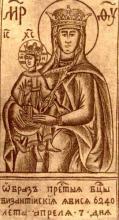 We know that this Icon appeared on April 7, 732. Later it was taken from Rome to Russia. In 1709, after the Battle of Poltava, Emperor Peter the Great prayed before it, and offered up words of thanks and praise to the Lord for having given him such a glorious victory over the foe. One should not confuse this Icon with the Tsar’grad [Imperial City] Icon, celebrated on April 25 and September 17, or with the Constantinople Icon, which is celebrated on May 11. The Byzantine Icon is also celebrated on May 1.
We know that this Icon appeared on April 7, 732. Later it was taken from Rome to Russia. In 1709, after the Battle of Poltava, Emperor Peter the Great prayed before it, and offered up words of thanks and praise to the Lord for having given him such a glorious victory over the foe. One should not confuse this Icon with the Tsar’grad [Imperial City] Icon, celebrated on April 25 and September 17, or with the Constantinople Icon, which is celebrated on May 11. The Byzantine Icon is also celebrated on May 1.
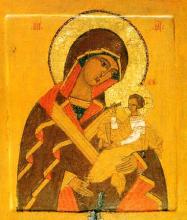 The miraculous Shuiskaya-Smolensk Icon of the Mother of God was written in 1654-1655 in the Resurrection parish of the town of Shui , where the plague relentlessly raged. Hoping in God’s mercy and the intercession of the Theotokos, parishioners of the Resurrection Type Church asked a certain pious monk to write an icon of the Smolensk Mother of God, an image that since antiquity had saved Russian people from enemies and woes. For an entire week, as the icon was being written, the parishioners continued to fast and pray. When the icon was done, the priest of the Resurrection Type Church and the people took it to the church and installed it in a place especially prepared for it. From that time on, the plague began to abate, at first in the area of the Name Resurrection Type Church , and later throughout the town. The icon installed in the church became the source of a multitude of miraculous healings, especially from disorders of the eyes.
The miraculous Shuiskaya-Smolensk Icon of the Mother of God was written in 1654-1655 in the Resurrection parish of the town of Shui , where the plague relentlessly raged. Hoping in God’s mercy and the intercession of the Theotokos, parishioners of the Resurrection Type Church asked a certain pious monk to write an icon of the Smolensk Mother of God, an image that since antiquity had saved Russian people from enemies and woes. For an entire week, as the icon was being written, the parishioners continued to fast and pray. When the icon was done, the priest of the Resurrection Type Church and the people took it to the church and installed it in a place especially prepared for it. From that time on, the plague began to abate, at first in the area of the Name Resurrection Type Church , and later throughout the town. The icon installed in the church became the source of a multitude of miraculous healings, especially from disorders of the eyes.
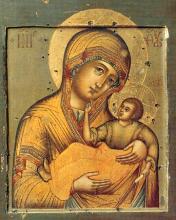 The Holy Icon known as the “Muromskaya” or Murom Icon was brought from Kiev to Murom at the beginning of the 12th Century by St. Constantine, Prince of Murom. Constantine had long striven to persuade the pagan people to adopt the Christian Faith. The idol-worshippers not only refused, but angrily conspired to kill him. Getting word of this, the pious prince fervently prayed to God and, bringing with him the Icon of the Mother of God, went out to meet them. The pagans, seized by some invisible terror, immediately had a change of heart, and sought baptism.
The Holy Icon known as the “Muromskaya” or Murom Icon was brought from Kiev to Murom at the beginning of the 12th Century by St. Constantine, Prince of Murom. Constantine had long striven to persuade the pagan people to adopt the Christian Faith. The idol-worshippers not only refused, but angrily conspired to kill him. Getting word of this, the pious prince fervently prayed to God and, bringing with him the Icon of the Mother of God, went out to meet them. The pagans, seized by some invisible terror, immediately had a change of heart, and sought baptism.
At the close of the 13th Century, St. Basil was the bishop of Murom. The people, blinded by duplicitous slander, suspected him of living a corrupt life, and wanted to kill him. Holy Hierarch Basil requested that his death be put off until morning. Throughout the night, and to the third hour of the day, he prayed in the church of the Holy Passion-bearers Boris and Gleb. In the morning, having served the Liturgy, he entered the Church of the Annunciation, and there, before the Icon of the Mother of God which had been brought from Kiev by prince Constantine, he served a moleben. Placing his hope of salvation on the Divine Intercessor, he took the Holy Icon, and went out of the church and to came to the River Oka, where he took off his mantia, spread it upon the water, and holding the Icon, stepped onto the mantia. Then a strong wind carried him against the current. At the 9th hour of the day, he came to the place known as Staraya [Old] Ryazan’, where the princes Fyodor and Constantine dwelt. The princes, the clergy, and the people came out in a Procession of the Cross to meet the miraculous traveler. From that day, the diocesan see of Murom ceased to exist, and a new diocese of Ryazan’ was established through the prayers of St. Basil. There the Miraculous Icon remained until, three years later, Holy Hierarch Basil chose New Ryazan’, a site better protected from the Mongols, as his dwelling, and there in 1291 established his kathedra. There he brought the Murom Icon.
According to an ukaz by the Holy Synod, and at the request of the people of Murom, April 12th [O.S.] was established as the Icon’s Feast Day.
The Belynich Icon of the Mother of God
12/25 April
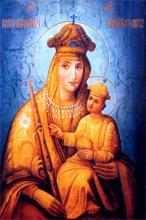 The Belynich Icon of the Mother of God was originally in one of the Orthodox churches in Mogilev Province. After the Unia (signed in 1596), the Icon was transferred to Catholic control, and was installed in the church of the Catholic Belynich Monastery established in 1622-1624 by great hetman Lev Sapega on the banks of the Druga, about 50 kilometers from Mogilev. The Icon was revered by Catholic and Orthodox people alike. In 1832 the Monastery was dissolved, and the church became a parish church.
The Belynich Icon of the Mother of God was originally in one of the Orthodox churches in Mogilev Province. After the Unia (signed in 1596), the Icon was transferred to Catholic control, and was installed in the church of the Catholic Belynich Monastery established in 1622-1624 by great hetman Lev Sapega on the banks of the Druga, about 50 kilometers from Mogilev. The Icon was revered by Catholic and Orthodox people alike. In 1832 the Monastery was dissolved, and the church became a parish church.
With the restoration of the Monastery in 1876, the church was turned over to the Orthodox. On April 12 of the same year, the first Divine Liturgy was served on an Altar Table dedicated to the Nativity of the Most-holy Theotokos and consecrated by an Orthodox bishop. The Belynich Icon of the Mother of God is venerated throughout the Christian world.
"Vilenskaya" (Vilnius) Icon
14/27 April
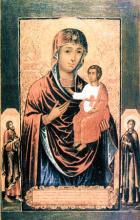 According to local tradition, the Vilenskaya Icon was written by the Holy Apostle and Evangelist Luke. Elena, daughter of John III Vasilievitch, unifier of Russia, brought the Icon to Vilno in token of her parents' blessing, on the occasion of her marriage in 1495 to Alexander, Prince of Lithuania. After Elena's death, the Icon was installed in the Church of the All-holy, in which she had been interred. Later, the Icon was translated to the Cathedral of the Holy Trinity in Vilno, where it remained until the Revolution of 1917. In a men's monastery near Vilno, another Vilno Icon of the Mother of God appeared in 1341. On that Icon, the Mother of God was pictured at full length, standing upon a depiction of the moon; with angels holding a crown over her head.
According to local tradition, the Vilenskaya Icon was written by the Holy Apostle and Evangelist Luke. Elena, daughter of John III Vasilievitch, unifier of Russia, brought the Icon to Vilno in token of her parents' blessing, on the occasion of her marriage in 1495 to Alexander, Prince of Lithuania. After Elena's death, the Icon was installed in the Church of the All-holy, in which she had been interred. Later, the Icon was translated to the Cathedral of the Holy Trinity in Vilno, where it remained until the Revolution of 1917. In a men's monastery near Vilno, another Vilno Icon of the Mother of God appeared in 1341. On that Icon, the Mother of God was pictured at full length, standing upon a depiction of the moon; with angels holding a crown over her head.
"Ilyin-Chernigov" Icon
16/29 April
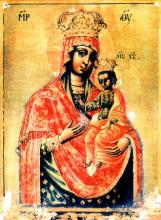 Until the revolution of 1917, there was in the Holy Trinity - Ilinsk [St Elias] Monastery near Chernigov, on Boldino hill, a miraculous image of the Mother of God, written in 1658 by the monk Gennady, and known as the Ilinsk-Chernigov image.
Until the revolution of 1917, there was in the Holy Trinity - Ilinsk [St Elias] Monastery near Chernigov, on Boldino hill, a miraculous image of the Mother of God, written in 1658 by the monk Gennady, and known as the Ilinsk-Chernigov image.
While Lazar Baranovich was Archbishop of Chernigov and Zosima was Abbot of the Ilinsk monastery, tears poured forth from this icon from the 16th to the 24th of April, 1662, as a sign of mercy. Almost all of the residents of Chernigov bore witness to this miracle. Soon afterwards in that same year, the Tatars attacked Chernigov and devastated all of the surrounding villages. However, the monks of the Ilinsk monastery knew nothing of the imminent danger. In the night, they received the news. After rushing to the church, and earnestly, tearfully, praying to their Heavenly Intercessor, they hid in the Anthony cave. At midnight the Tatars broke into the monastery, looted the church, and seized the church plate, but the miraculous icon with all of its precious decorations remained untouched. An unseen power did not permit the barbarians to touch the Holy Icon. That same unseen force kept them from entering the cave where the monks were hiding, although the Tatars strove many times to do so, approaching with lighted torches and bared swords. Suddenly, terrified by an incomprehensible vision, they fled.
St. Dimitry of Rostov, after describing 24 miracles wrought by the miraculous Ilinsk Icon, concludes his book The Bedewed Fleece by saying, "The end of this book, but not of the miracles of the Most-holy Theotokos, for who can enumerate them?"
The Myrrh-streaming Icon of the Iveron Mother of God
February 12/25, Bright Tuesday, October 13/26
The Tradition
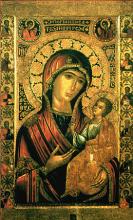 The original Miraculous Icon of the Iveron Mother of God is on Mount Athos, the famous center of Orthodox monasticism (known also as Agion Oros - Greek for the "Holy Mountain"). By tradition, it was painted by the apostle and evangelist Luke.
The original Miraculous Icon of the Iveron Mother of God is on Mount Athos, the famous center of Orthodox monasticism (known also as Agion Oros - Greek for the "Holy Mountain"). By tradition, it was painted by the apostle and evangelist Luke.
In the 9th century, this Icon was in the possession of a widow who lived in Nicea. This town in Asia Minor no longer exists, but in its time it was the venue for two Ecumenical Councils; the first, which composed the first eight articles of Nicean Creed, and the seventh, which reinstituted the veneration of icons after a lengthy struggle with the iconoclast heresy, which had erroneously equated the veneration of icons to idol worship.
It was during the reign of the iconoclast Byzantine emperor Theophilus that soldiers came to the house of the widow, where in a small chapel the Iveron Icon of the Mother of God occupied a place of honor. One of the soldiers struck the Icon with his sword, and immediately blood began to flow from the gashed cheek of the Virgin. Shaken by this miracle, the soldier instantly repented, renounced the iconoclast heresy, and entered a monastery. On his advice, the widow concealed the Icon in order to avert its further desecration. After praying for guidance before the Icon, the widow put the Holy Image into the sea. To her immense surprise and joy the Icon did not sink but, remaining upright, drifted away in a westerly direction. Fleeing persecution, the widow's son left Nicea and went to Mt. Athos where he led a saintly life as a monk to the end of his days. There he recounted the story of how his mother had set the Holy Icon upon the waves, and this story was handed down from one generation of monks to another.
Many years later this Icon appeared on the Holy Mountain ("in a pillar of fire" as Athonite tradition recounts) from the sea, close by the Iveron monastery. At that time the holy monk Gabriel was one of the brotherhood in this monastery. The Mother of God appeared to him in a vision and directed him to convey to the abbot and brothers of the monastery that She wished them to have Her Icon as their help and salvation. She told Gabriel to approach the Icon on the waters without fear and take it with his hands. Obedient to the words of the Mother of God, says Athonite tradition, Gabriel "walked upon the waters as though upon dry land," took up the Icon and brought it back to the shore. The icon was then brought into the monastery and placed in the altar. On the next day the Icon disappeared from the sanctuary, and was found on the wall beside the monastery gate. It was returned to the altar, but the next day it was again found by the gate. This recurred several times, until the the Holy Virgin revealed to the monk Gabriel that it was not Her wish for the Icon to be protected by the monks, but that She wished to protect them. After this, a church was built near the monastery gate where the Icon resides to this day. In connection with the name of the monastery the Icon came to be known as the "Iveron" Mother of God, and because of its location, the "Portaitissa," or "Gatekeeper." In addition to many miraculous hearings, the Holy Virgin demonstrated Her protection of the Iveron Monastery during various assaults by Saracen pirates.
News of this wonder-working Icon reached Russia through pilgrims who had visited Mt. Athos. In the 17th century Archimandrite Nikon of Moscow (later to become Patriarch) asked the abbot of the Iveron monastery to send a copy of the Icon to Russia, and this request was fulfilled. The copy of this Icon also began to work miracles and a special chapel was built for it next to the Kremlin walls in Moscow, where it was especially revered by the Russian people until the Revolution of 1917. The chapel was destroyed by the Bolsheviks and the fate of the Icon is not known.
The Contemporary Miracle
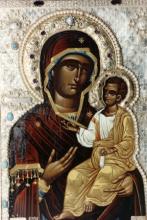 In 1982, a Chilean convert to Orthodoxy, Jose Munoz, in the company of two friends, embarked from Canada to the ancient bastion of Orthodox monasticism, Mt. Athos, on a pilgrimage. An art teacher by profession, he is also an iconographer, and therefore wished to visit some of the sketes (small monastic communities dependent upon one of the 20 major monasteries of Athos) and monasteries which specialize in icon painting. One of the friends who had accompanied Jose decided to become a monk and remained on Mt. Athos in one of the smaller sketes; Jose and his other companion directed themselves towards the Danilov skete, where icons are painted in the ancient Byzantine style using the egg tempera technique.
In 1982, a Chilean convert to Orthodoxy, Jose Munoz, in the company of two friends, embarked from Canada to the ancient bastion of Orthodox monasticism, Mt. Athos, on a pilgrimage. An art teacher by profession, he is also an iconographer, and therefore wished to visit some of the sketes (small monastic communities dependent upon one of the 20 major monasteries of Athos) and monasteries which specialize in icon painting. One of the friends who had accompanied Jose decided to become a monk and remained on Mt. Athos in one of the smaller sketes; Jose and his other companion directed themselves towards the Danilov skete, where icons are painted in the ancient Byzantine style using the egg tempera technique.
After eight hours of climbing uphill on rough terrain, they were very tired and decided to stop at a skete which they could see on the the Mountainside below. This skete, dedicated to the Nativity of Christ, is very poor and its 14 monks keep a strict monastic rule. The abbot, Fr. Klimentos, greeted them warmly and offered traditional Athonite hospitality. Then he took them to see the skete's icon-painting studio.
As soon as he entered the studio, Jose felt an immediate and indescribable attraction to a copy of the Iveron Icon of the Mother of God which hung on one of the walls. As he later explained, his heart felt as though it had 'leaped or turned over. " He asked whether he could buy this Icon, but was told repeatedly that it was one of the first icons which had been painted at this skete ( by one Fr. Chrysostomos in 1981) and was not for sale at any price.
That night at a divine service in the church of the skete, during the singing of the angelic hymn to the Theotokos "It is Meet" (one of the chief prayers of the Orthodox Church to the Mother of God), Jose fell to his knees and begged the Mother of God to make it possible for him to take the Icon back with him into the world, where "we have need of You." Immediately he felt an assurance that somehow his prayer would be answered. The next morning, as Jose and his friend were about to depart, the abbot appeared holding the Icon and said to Jose that it pleased the Mother of God for Her Icon to go with him to North America.
Jose and his companion went down the mountain and took the the boat towards Daphne, a port on the western shore of the peninsula. On the way, Jose heard a strong inner voice which bade him: "Go to the Iveron monastery and touch your Icon to the original wonder-working Iveron Icon." This they did.
Upon arrival at the Iveron monastery they waited three hours before a monk came to open the church which houses the original "Portaitissa." Jose asked that the protective icon case be opened so that his Icon could be placed upon the original Portaitissa in order to be directly blessed by the Mother of God. The monk was suprised, but agreed to Jose's request when it was explained to him that Jose and his companion wished to take the blessing of the Mother of God to the West where Her intercession is much needed.
Returning to his home in Montreal, Canada, Jose placed the Iveron Mother of God in his icon corner, where he also kept relics of the saints from the Kiev Caves monastery and of the Grand Duchess Elizabeth (one of the New Martyrs of Russia).
Jose began to read a daily Akathist (hymns of praise) before his newly-acquired Icon. At about 4 a.m. on Nov. 24, 1982 (three weeks after his return from Mt. Athos), Jose woke up to the smell of a very strong fragrance, as though someone had spilled a bottle of exquisite perfume. He thought at first that the fragrance emanated from the relics but later, when he stood before the Icon to say his morning prayers, he saw that the hands of the Mother of God were streaked with oil. Jose assumed that a friend who was sharing the house had spilled some oil onto the Icon while adjusting the flame of the vigil lamp hanging before it, but the friend denied touching the lamp. When Jose wiped the Icon, he discovered that it was the source of the wonderful fragrance which had by now filled the whole house.
Upon the advice of a local Orthodox clergyman, the Icon was taken to church and placed on the altar. During the entire liturgy, myrrh flowed from the hands of the Christ Child. Since that time, with the exception of several days during Holy Week, when the Icon is absolutely dry, the myrrh has continued to flow almost uninterruptedly. (Holy Myrrh is a sweet, fragrant oil which was used in the Old Testament for the anointing of kings. In contemporary Orthodox church practice, a newly born Christian is anointed with Holy Myrrh during which the words "The seal of the gift of the Holy Spirit" are said by the priest.)
In the years since, Jose has traveled to many cities and parishes where the Icon has been venerated to the great joy and consolation of the faithful.
Wherever the Icon goes, there are always many questions. Some people initially have doubts. A scientist in Miami was astounded to see that the back of the Icon remained perfectly dry. He later surreptitiously chipped off a small piece of the board on which the Icon is painted for scientific analysis: it was found to be ordinary pine wood, nothing more.
At some times the myrrh flows in greater abundance than at others. During the consecration of a bishop in Montreal there was such an outpouring of the myrrh, that it streamed down from the analogion (lectern on which icons are kept in Orthodox churches) onto the floor. On another occasion, in Florida, the myrrh was seen to rise forth from the hands of the Mother of God and the Christ Child as though it were being pressed from within. Nobody has any power to regulate the flow of the myrrh, it moves to the will of God and His Most Pure Mother.
The Icon is kept in a frame about two inches deep and measures about 12 X 18 inches. At first the myrrh flowed only from the hands of the Mother of God, from the star on Her left shoulder and, occasionally, from the hands of Our Lord Jesus Christ. Yet in March 1985, during a Lenten service, even the frame and glass of the Icon began to exude myrrh in such quantities, that the cloth of the analogion on which it lay was totally saturated. There is always a layer of cotton wool at the base of the Icon to absorb the myrrh: pieces of this cotton are distributed to the faithful.
Although there have already been several cases of physical healing (not only among Orthodox, but Catholics and Protestants, too), the purpose of the Mother of God seems to be directed more at the healing of souls. Many who have stood before the Icon have testified to this, experiencing not only compunction and repentance, but consolation at the same time.
As mentioned earlier, the flow of myrrh ceases during Holy Week. It ceases on Holy Monday. After the liturgy on the morning of Great Saturday, a light dew of myrrh forms on the Icon, its case and protecting glass. During Matins (the midnight service at which the glorious Resurrection of Our Lord is proclaimed), when the procession of clergy and faithful, holding icons and banners, leaves the church, the Icon begins to exude myrrh in such quantities, that it covers the hands of the person who is carrying it.
This is not the first time that the Orthodox Church has witnessed such a miracle. In the 19th century the Surety-of-Sinners Icon in Moscow exuded myrrh with which the sick were anointed and received healing. Earlier, there was a myrrh-streaming icon of the Mother of God in the Tolga monastery in Yaroslavl, and there have been others.
What is the meaning of this extraordinary manifestation of God's grace in our time? It has been observed that in the history of the Church such miracles have occurred in times of great tribulation; we saw this in the Apostolic times, and, more recently, in Russia, where the Church has suffered cruel persecution for 70 years. The miracles strengthen the faithful and prepare them to endure trials. The appearance of the myrrh-streaming Icon in our time may well signify a period of further great trials for the Russian Orthodox Church and, at the same time, offer consolation that the Mother of God will be a Protectress of the faithful: Unto whomsoever much is given, of him shall much be required.
Least Among the Brethren
 Jose Munoz formed the desire to become a monk while still a boy in Chile. He became converted to Holy Orthodoxy as a youth and began to lead a monastic life as best he could within the confines of the world, although he did not enter a monastery. Later he moved to Canada and continued to observe this way of life. When the miracle of the myrrh-streaming occurred, Jose vowed that he would never seek worldly gain from the Icon. Therefore any collections taken up during church services at which the Icon is present are sent to the poorest monasteries and sketes on Mt. Athos and/or to help those persecuted for their faith in the Soviet Union and their families. Jose never accepts any money for himself while traveling with the Icon, although he is forced to take much time off from his teaching and icon painting, which are his only sources of gainful employment.
Jose Munoz formed the desire to become a monk while still a boy in Chile. He became converted to Holy Orthodoxy as a youth and began to lead a monastic life as best he could within the confines of the world, although he did not enter a monastery. Later he moved to Canada and continued to observe this way of life. When the miracle of the myrrh-streaming occurred, Jose vowed that he would never seek worldly gain from the Icon. Therefore any collections taken up during church services at which the Icon is present are sent to the poorest monasteries and sketes on Mt. Athos and/or to help those persecuted for their faith in the Soviet Union and their families. Jose never accepts any money for himself while traveling with the Icon, although he is forced to take much time off from his teaching and icon painting, which are his only sources of gainful employment.
When asked why he thinks he was chosen for such a miracle, Jose replies that, knowing his many weaknesses, he is at a loss to explain this; he feels that perhaps it was because God often reveals himself through the very least of His servants, and that as a convert, he feels himself to be the "least among the brethren." He regards himself not as the owner, but merely the custodian of the Icon, which properly belongs to the entire body of the faithful. From his childhood his mother, who is a devout Roman Catholic, taught him to love the Most Pure Virgin, therefore he always prayed to Her, though never asked Her for any signs or miracles.
Glory be to Our Lord Jesus Christ for manifesting through Jose, the 'least of His servants," the wonder-working Iveron Icon of the Mother of God!
Bright Friday
This icon has a wonderful and comforting appearance. Depicted is an enormous stone chalice, standing in a wide reservoir, filled with water. Above the chalice, holding in Her arms the Preeternal Infant and wearing a crown, hovers the Most Holy Virgin.
To the reservoir filled with life-giving water have streamed those who thirst. The unfortunate and life-weary drink of the water and become strong and invigorated. What a wonderful sign ...
It was the 5th century. At that time, in Constantinople, near the so-called "Golden Gates," there was a grove filled with cypress and plane trees, long since dedicated to the Most Holy Theotokos. Within the grove there was a spring, likewise long renowned as a source of miracles. Gradually, the site became overgrown with shrubbery, and the water receded into the mud. Only from the dampness of the earth could one deduce the existence of the spring.
Once upon a time, the warrior Leo Marcellus passed the site, where he met a helpless traveler, a blind man who had lost his way and could not find his way out. Leo helped him get out onto the path, and led the man, weakened by exhaustion, into the shade to rest, while he himself went off in search of water to refresh the blind one. Then he suddenly heard a voice say: "Leo, do not search far off for water. It is close by." Leo, amazed by the mysterious voice, began to look around, but could find no water. As he stood, sad and pensive, the same voice again addressed him: "King Leo! Go into the shade of the grove, draw of the water which you will find there, and give it to the one who thirsts. Place the mud which you find in the spring upon his eyes. Then you will learn who I am, who it is that for so long has blessed this site. Soon I will help you to erect here a church bearing My name, and all who come here and with faith call upon My name will have their prayers answered, and will be completely healed of their sicknesses.
As soon as Leo, hurriedly reaching the appointed place, had taken mud from the spring and placed it on the eyes of the blind man and had given him some of the water to drink, the blind man immediately regained hi s sight. Without a guide, he went into Constantinople, glorifying the grace of the Theotokos.
This occurred during the reign of Emperor Marcian (391-457).
Emperor Marcian was succeeded by Leo Marceilus (457-473). He remembered the appearance of the Theotokos, and ordered that the spring be cleaned of the ooze; earthworks were built to isolate the stream of that spring from other nearby springs, and the water was confined in a large circular stone pool, above which was built a church dedicated to the Theotokos.
Emperor Leo called this spring the "Life-giving Spring", for there was revealed the miraculous grace of the Theotokos.
One hundred years after Marcian, reigned the emperor Justinian the Great (527-565), a man greatly devoted to the Orthodox faith. For a long time he suffered from edema, finding no help from doctors, and already considering himself condemned to death. One midnight he heard a voice saying: "You, O king, cannot return to health unless you drink from My spring." The king did not know of which spring the voice spoke, and he fell into despair. Then, during the day, the Theotokos appeared to him, and said: "Arise, O king, go to My spring, and drink of it, and you will be healthy, as you were before." The sick man acted according to the Lady's will. He found the spring, drank of its water, and soon regained his health. Near the church built by Leo, the grateful emperor erected a new magnificent church, where later was founded a populous monastery.
In the 15th Century, the Imperial City fell into the hands of the Muslims. The famous Church of the Life-giving Spring was destroyed, and its building materials were used to construct the mosque of Sultan Bayazet. The church site was covered with earth and crushed stone, so that the very foundations of the church disappeared from sight. The beautiful surrounding areas were turned into a Muslim cemetery. A Turkish sentinel, placed at the ruins of the church, forbade Christians not only to gather at the site, but even to approach there.
Little by little, the strictness of this ban eased, and Christians were permitted to build a small church there. However, in 1821, it was destroyed as well, and the spring itself was filled in. Once again Christians cleaned up the ruins, reopened the spring, and once again drew water from it. Even upon these shards of the former magnificent holy structure, the Theotokos, as before, granted hearings through Her grace. Later, among the broken pieces in one of the windows was found, already half-rotted away through time and dampness, a panel on which were recorded 10 miracles which occurred at the Life-giving Spring during the period 1824-1829.
During the reign of Sultan Mahmoud, the Orthodox received a measure of freedom to conduct religious services. They used it to erect, for the third time, a church above the Life-giving Spring. In 1835, with great pomp, the Ecumenical Patriarch Constantine, celebrating with 20 bishops and an enormous flood of the faithful, consecrated the church which stands to this day. Nearby was built a hospital and alms-house. Even the Muslims spoke with great respect of the Life-giving Spring, and of the Theotokos, Who through it pours out Her grace-filled power. "Great among women Holy Mary" is how they refer to the Most Holy Virgin. The water from the Life-giving Spring they call the "water of Holy Mary."
It is impossible to recount all of the miracles flowing from the Life-giving Spring and bringing grace to kings, to patriarchs, to noted as well as ordinary people. The power of grace acts to this day through the water of the spring. That power is personally experienced not only by Orthodox, but by Catholics, Armenians, and even by the Turks.
PARISH LIFE
RECENT VIDEOS
Address of our Cathedral
Subscribe to our mailing list
While all the materials on this site are copyrighted, you may use them freely as long as you treat them
with respect and provide attribution on the Russian Orthodox Cathedral of St.John the Baptist of Washington DC.



